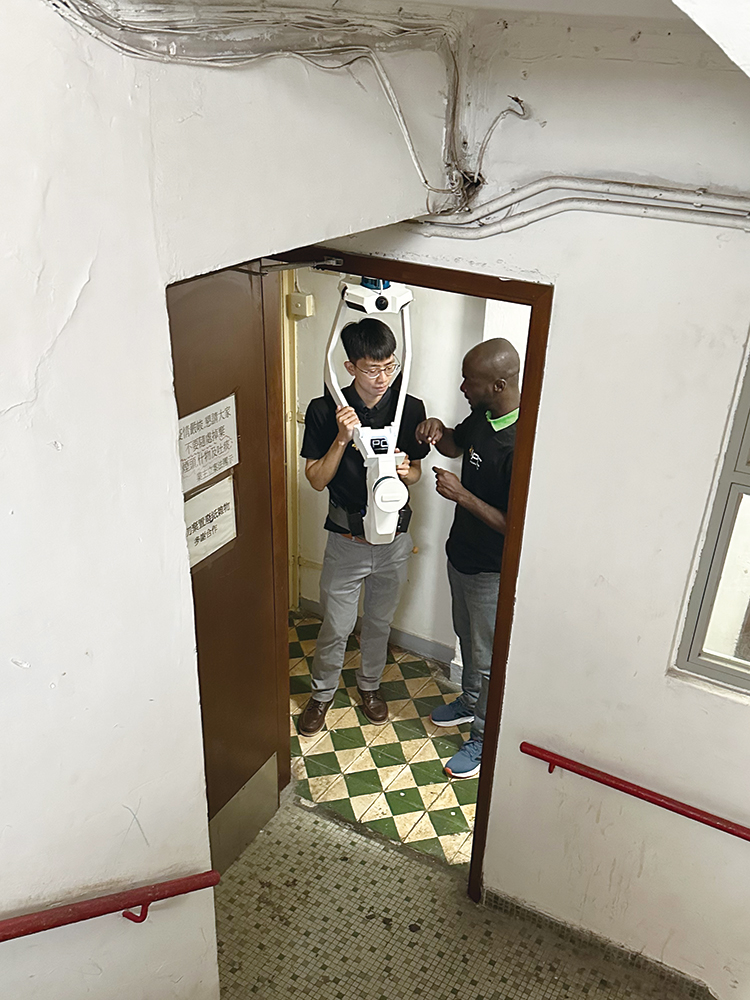May 2025 | Volume 26 No. 2
Safety First
Listen to this article:
The project, which is a collaboration between the Faculty of Architecture’s MetaBIM Research Lab and the Home Affairs Department (HAD), was born out of a tragedy in March 2022, when fire swept through a subdivided tenement in Mong Kok district, killing one woman.
“My team and I asked: How can firefighters systematically inspect risks if even building blueprints are missing?” said Dr Landson Li, formerly a PhD student with the MetaBIM Research Lab. The solution was to undertake 3D scanning and Building Information Modelling (BIM) for buildings, thereby replacing missing fire safety data.
Describing the collaboration with the HAD as ‘a collision of pain points and innovation’, Dr Li said: “HAD needed solutions for missing fire safety data in old buildings, while our business is BIM and our team had already developed wearable mobile scanning technology.”
During a demonstration, the team scanned an entire floor in 10 minutes. “When the 3D model revealed an illegal rooftop structure, an HAD officer said, ‘This is how building management should work in the 21st century’,” said Dr Li. “This is one of our successful direct collaborations, and it builds on years of trust in technology between HKU and the government in BIM standardisation.”

A wearable mobile device is used to conduct 3D scanning inside a building.
Gamifying diagnostics
The pilot programme gamifies fire safety diagnostics in three parts. First, they capture the data by scanning the building. “Scanning stairwells feels like mapping a VR game – details like wires hidden in wall cracks are recorded,” said Dr Li.
Next is AI analysis, when their system flags information such as misplaced fire extinguishers (and highlights them in red) and guides users to the nearest valid extinguishers via green arrows. Finally, there is a collaborative simulation, which enables fire departments to place virtual fire sources in the model to test evacuation times.
“For example, the AI detected a security gate blocking 70 per cent of an escape route. It instantly generated a retrofit plan – a task that traditionally would have required multiple site visits and discussions,” said Dr Li.
Captured data is turned into a 3D BIM model, then owners can scan a QR code to revisit the building and compare pre/post-renovation states. Smart modelling enables the team to include point clouds with fire safety metadata, such as having a water pipe showing its installation year and maintenance history. And immersive reviewing technology enables firefighters to use VR headsets to walk through virtual buildings, thereby taking the guesswork out of what a fire would look like in dark stairwells.
Silent killers
“What we are specifically looking for in the older buildings are silent killers,” said Dr Li. “For example structural traps such as illegal rooftop structures which have shrunk escape routes. These appear as ‘heat maps’ or red zones in models. We’re also looking for potential time bombs: our AI compares annual scans to spot risks like a load-bearing wall crack widening by 0.2mm yearly – invisible to the eye but catastrophic in a fire.”
The technology also enables users to simulate likely scenarios should a building catch fire. “In one case, for example, all fire extinguishers in a building were on the ground floor,” said Dr Li. “We did a simulation which showed it would take residents 2 minutes 15 seconds to retrieve extinguishers from the fifth floor – far exceeding the golden rescue window.
“We recommended adding extinguishers on every floor and provided three retrofit plans costing under HK$5,000. The system even auto-generates construction drawings compliant with the Buildings Department’s guidelines.”
The technology has great potential for other uses in other fields such as: public health, where it could be used for identifying poorly ventilated subdivided units to prevent disease outbreaks; cultural preservation, through creating digital archives of soon-to-be-demolished buildings for the metaverse; and ‘insurtech’, for developing dynamic fire insurance premiums based on building risk scores.
Smart community
The team is open to sharing their experiences with other applications to build a better smart community. “Programmes like this are another big step towards creating ‘smart cities’,” said Dr Li.
He describes a heartfelt moment in one of the scanned building projects: “After seeing clutter blocking her doorway flagged as a risk in the model, 78-year-old Mrs Lee organised neighbours to clear it. She told me, ‘The computer showed me that those boxes I stepped over every day really were blocking a lifeline’. Her words really made me think: technology shouldn’t be cold data – it must make safety tangible.”
For the next step, the MetaBIM Research Lab team would like to connect more with people and real living environments via technology. “It’s important to provide services that can tackle key items and improve our quality of life,” Dr Li said. “More can be done on this through BIM and AI technology – turning all physical buildings into digital assets managed by cutting-edge AI technology to ensure the city environment really fits human needs.”
AI detected a security gate blocking 70 per cent of an escape route. It instantly generated a retrofit plan – a task that traditionally would have required multiple site visits and discussions.

Dr Landson Li

